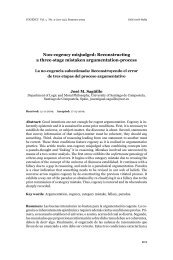Cogency v2 n2
Cogency v2 n2
Cogency v2 n2
You also want an ePaper? Increase the reach of your titles
YUMPU automatically turns print PDFs into web optimized ePapers that Google loves.
You can’t step into the same Argument twice: Wittgenstein... / D. H. COHEN<br />
Because the Investigations is more concerned with unsettling accepted<br />
philosophical positions than establishing one of its own, it snipes at them<br />
from a number of different standpoints rather than arguing from or for a<br />
single standpoint. Consequently, it would be a mistake to take a single passage<br />
out of the larger context and read it as a self-contained argument to<br />
serve as a case study as we did above for the Tractatus. Nevertheless, the<br />
Investigations’ questions and critiques can have a cumulative effect comparable<br />
to a successful argument, viz., rationally persuading the reader to<br />
reconsider her standpoint. Instead of trying to isolate a discrete argument,<br />
we will look at how Wittgenstein’s use of the “Slab!” language example evolves<br />
across several texts in order to trace the development of his philosophical<br />
methodology.<br />
Wittgenstein opens both the Brown Book and the Investigations by considering<br />
a passage on language from Augustine in which learning a language<br />
is described as learning names for things. He then introduces the simple<br />
“slab language” as one for which Augustine’s description initially appears to<br />
be correct (but appearances can be deceiving!). There are several conclusions<br />
that can be drawn from his discussion, including a complete rejection<br />
of the Tractarian argument we just analyzed that there must be ultimate<br />
simples and that there is one and only one complete analysis of a proposition<br />
(Tractatus 2.02, 3.25). Wittgenstein no longer thinks that it is a matter<br />
to be decided by a logical grammar whether “Brick!” is to be translated by<br />
one word or four. There is no “fact of the matter” when it comes to that kind<br />
of analysis. This is a complete reversal of the earlier position, but the larger<br />
point we are trying to make concerns the point, not the content, of the argument,<br />
and that becomes visible on inspection of its form (admittedly a painstaking<br />
and perhaps overly pedantic exercise, but justified, we believe, by the<br />
interpretive insights it yields).<br />
The presentation of the slab language in the Brown Book is followed by<br />
a page-long parenthetical note in the form of an internal dialogue beginning<br />
with these words:<br />
Note. Objection: The word “brick” in language 1) has not the meaning<br />
which it has in our language.–This is true if it means that in our language<br />
there are uses of the word “brick” different from our usages of this<br />
word in language 1). But don’t we sometimes use the word “brick!” in<br />
33








